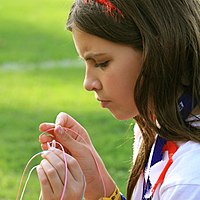
Photo from wikipedia
Self-report personality tests widely used in clinical, medical, forensic, and organizational areas of psychological assessment are susceptible to faking. Several approaches have been developed to prevent or detect faking, which… Click to show full abstract
Self-report personality tests widely used in clinical, medical, forensic, and organizational areas of psychological assessment are susceptible to faking. Several approaches have been developed to prevent or detect faking, which are based on the use of faking warnings, ipsative items, social desirability scales, and validity scales. The approach proposed in this work deals with the use of overt items (the construct is clear to test-takers) and covert items (the construct is obscure to test-takers). Covert items are expected to be more resistant to faking than overt items. Two hundred sixty-seven individuals were presented with an alexithymia scale. Two experimental conditions were considered. Respondents in the faking condition were asked to reproduce the profile of an alexithymic individual, whereas those in the sincere condition were not asked to exhibit a particular alexithymia profile. The items of the scale were categorized as overt or covert by expert psychotherapists and analyzed through Rasch models. Respondents in the faking condition were able to exhibit measures of alexithymia in the required direction. This occurred for both overt and covert items, but to a greater extent for overt items. Differently from overt items, covert items defined a latent variable whose meaning was shared between respondents in the sincere and faking condition, and resistant to deliberate distortion. Rasch fit statistics indicated unexpected responses more often for respondents in the faking condition than for those in the sincere condition and, in particular, for the responses to overt items by individuals in the faking condition. More than half of the respondents in the faking condition showed a drift rate (difference between the alexithymia levels estimated on the responses to overt and covert items) significantly larger than that observed in the respondents in the sincere condition.
Journal Title: Frontiers in Psychology
Year Published: 2018
Link to full text (if available)
Share on Social Media: Sign Up to like & get
recommendations!